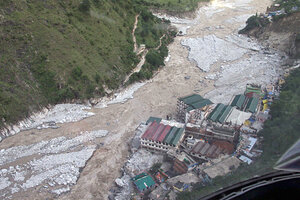In India, floods strand thousands in rapidly-developed hills
A report by India's Comptroller and Auditor General three years ago warned that massive expansion of hydropower projects in the area could be catastrophic in the event of a flash flood.

Flood waters flow next to a residential complex after heavy rains in the Himalayan state of Uttarakhand June 19. India's monsoon rains could ease soon after hitting 89 percent over averages in the week to June 19, according to weather office sources, in a third straight week of downpours that have caused major flooding in north India.
Reuters
New Delhi
At least 160 people have died and thousands are stranded or missing after brief torrential rains caused massive flooding and landslides in the Himalayan foothills of India's Uttarakhand state, northeast of Delhi.
Many expect the number of casualties to rise, as bodies are said to have been washed away by the flash flooding. Among some 60,000 stranded are Hindu pilgrims from across India, visiting the area’s holy shrines. Currently some 45 military helicopters and 10,000 troops are engaged in rescue operations hampered by washed roads, bad weather, and continuing landslides. Still, some 33,192 pilgrims had been rescued as of Thursday, according to a ministry press release.
“The tragedy is huge and damages tremendous with vast tracts of land still submerged under tons of debris. The casualties could run into several hundreds,” the state's chief minister, Vijay Bahuguna, said in a press conference Thursday.
Analysts and environmental activists say the tragedy is man-made, blaming the government’s drive to increase infrastructure at too fast a rate.
"The damage has not taken place only because of water, which tends to flow away. It has happened due to the sediments and debris that has come with the water, thanks to the intense blasting deep inside the mountains for two hydro-power projects," says Bharat Jhunjhunwala, an environmental activist who lives nearby.
"Aquatic life and ecological balance in the hills has been disturbed by the hydropower projects," Mr. Jhunjhunwala says. "This is the price we are paying for Prime Minister Manmohan Singh's single-minded determination to produce electricity at whatever cost."
A report by India's Comptroller and Auditor General three years ago warned that more than 200 hydropower projects in the state were overlooking environmental concerns, which could be catastrophic in the event of a flash flood. Pointing out that massive deforestation was not being met with any serious reforestation, the report had said that in the event of a flood "the river will behave as 'hungry waters' scouring sediments from riverbeds and river banks downstream to restore the natural sediment levels of the water."
Ecological mismanagement such as hydropower projects, the expansion of roads, and tourism infrastructure all contributed to the disaster, according to the report. The way to prevent this in the future, say analysts is to take a more calculating look at updating India’s infrastructure.
"This massive and singularly unfortunate calamity is telling us that we need to re-look at how we develop,” says Sunita Narain, director of the Centre for Science and Environment. “We must regulate our infrastructure growth for tourism. The government needs to be better prepared with improved infrastructure to meet this kind of eventuality and avoid such destruction to life and property. Even though the terrain in this part of India has its limitations, the government should reach out to people with warning signs well in advance."

